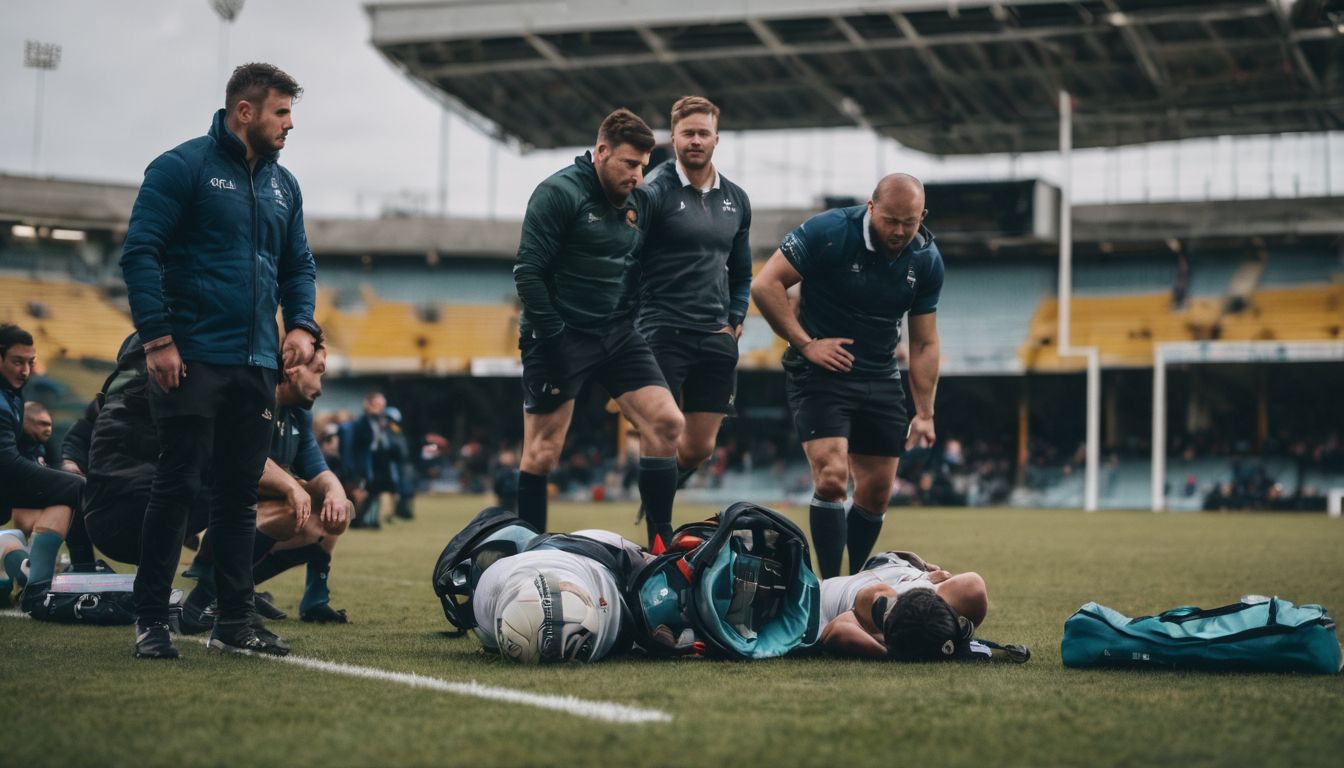Blood on the pitch can halt play and raise concerns about player safety. The Blood Replacement Rule allows injured athletes to receive necessary care without their team being disadvantaged.
This post explains how this rule keeps sports like rugby fair and safe while managing blood injuries effectively. Keep reading for the inside scoop!
Key Takeaways
- The Blood Replacement Rule allows for a temporary player substitution for up to 15 minutes in sports like rugby when an athlete suffers a blood injury, ensuring the team isn’t disadvantaged and the injured player receives prompt care.
- Match day medical staff are essential in managing blood injuries under this rule by providing immediate treatment on the field, which includes controlling bleeding and administering wound care within set time constraints.
- Violations of the Blood Replacement Rule can lead to penalties such as player suspension or team fines, highlighting its importance in maintaining fairness and safety in sports competitions.
- Ordering blood products for transfusion adheres to a 72 – hour rule to ensure freshness and effectiveness; also, regular antibody screens are carried out for compatibility and safety measures.
- High school sports apply National Blood Rules to protect student athletes during gameplay, enforcing safe practices relating to handling blood injuries on the pitch.
Understanding the Blood Replacement Rule
The Blood Replacement Rule is a key regulation in sports that allows for temporary substitution of players with a blood injury. It has been implemented across various sports and has specific guidelines for its application.
Definition and purpose
In rugby, a player’s sudden injury that causes bleeding can stop the game. To handle this, the blood replacement rule steps in. It lets injured players leave the field for medical treatment without their team suffering a disadvantage.
A temporary substitute comes on while doctors control and manage the player’s wound, ensuring they can return swiftly to action if safe to do so.
Its main goal is safety – both for the player who’s hurt and others on the pitch. Bloody injuries pose risks of infection or more serious complications if not treated properly and quickly.
Moreover, this rule keeps matches fair, allowing teams to stay at full strength while caring for their wounded players without permanently losing them from play during crucial moments.
History of the rule
The blood replacement rule has a long history dating back to the early days of rugby. It was first introduced as a measure to ensure the safety and well-being of players who suffered from open injuries during matches.
Over time, it has evolved to become an essential part of the sport’s medical protocols, allowing for quick and effective management of bleeding on the field. The rule has undergone several refinements based on scientific evidence and guidelines, ensuring that it continues to serve its purpose in maintaining player safety and providing timely medical attention when needed.
Application in different sports
Implemented in various sports, the blood replacement rule enables medical staff to provide necessary treatment for players experiencing blood injuries. It is widely applied in rugby, football, and hockey among other contact sports.
In these sports, the rule allows temporary substitution of up to 15 minutes for medical teams to manage bleeding effectively. This ensures that athletes receive timely care without compromising fairness or safety during matches.
In addition to rugby, sports like football and hockey also adhere to the blood replacement rule as a means of prioritising player welfare. The application of this rule across different disciplines emphasises the commitment of sports organisations towards ensuring the health and safety of their athletes during competition.
Blood Injury and Temporary Substitution
A blood injury in rugby refers to any open injury that results in bleeding. When a player sustains a blood injury, they may be temporarily substituted on the field until the wound is properly cleansed and dressed by the match day medical staff.
What constitutes a blood injury
An open injury, such as a laceration or abrasion, leading to visible blood or haemorrhage characterises a blood injury. These injuries can occur during physical contact in rugby, resulting in the need for immediate medical attention.
It is essential for match day medical staff to promptly identify and address these types of injuries to prevent excessive blood loss and potential spread of infection on the field.
The recognition and treatment of a blood injury underpin the application of the blood replacement rule, ensuring player safety and efficient wound management.
Temporary substitution and its time frame
- The time frame of 15 minutes provides sufficient opportunity for immediate medical intervention to address the blood injury, facilitating quick and thorough wound management.
- It allows medical staff to assess and treat the player without causing undue delay in addressing the injury and ensuring a safe return to play.
- This provision ensures that the team does not face unnecessary disadvantage due to an injury, as prompt treatment is provided while maintaining fair competition.
- The limited time frame of 15 minutes emphasises the importance of efficiency in managing blood injuries while minimising disruption to the game.
Role of match day medical staff
During a rugby match, the role of match day medical staff is crucial in ensuring the safety and well-being of players. They are responsible for assessing and treating any injuries, including blood-related injuries, to minimise the risk of further complications.
Additionally, they play a key role in implementing the blood replacement rule by promptly attending to bleeding players and providing necessary treatment within the designated time frame.
The medical staff’s quick response helps to control bleeding, clean wounds, and ensure that proper wound care is administered effectively on the field.
Moreover, match day medical staff also work closely with team physicians and other healthcare professionals to make timely decisions regarding temporary substitutions for blood-related injuries.
Indications for Blood and Blood Product Transfusion
The reasons for transfusion, transfusion triggers and the scientific evidence behind it. Read on to understand why blood and blood product transfusions are necessary in sports.
Reasons for transfusion
Reasons for transfusion:
- Severe anemia caused by blood loss or lack of red blood cell production, requiring a boost in red blood cells to improve oxygen delivery.
- Treatment of bleeding disorders such as hemophilia, where clotting factors are deficient, leading to excessive bleeding even from minor injuries.
- Management of trauma – related hemorrhage to replace lost blood volume and maintain vital organ perfusion.
- Supportive care for patients undergoing major surgeries or experiencing complications during surgery that require rapid blood volume replacement.
- Addressing severe infections or sepsis that lead to dangerously low platelet levels, contributing to uncontrolled bleeding.
- Providing relief for patients with bone marrow failure due to leukemia or chemotherapy, necessitating transfusions to support immune function and prevent life-threatening complications.
Transfusion triggers
The decision to transfuse blood or blood products is typically based on the individual patient’s clinical condition and specific laboratory values. Indications for transfusion depend on various factors, including the severity of a patient’s condition, their symptoms, and the underlying cause of their illness.
These triggers can include low levels of haemoglobin or haematocrit, active bleeding, signs of inadequate tissue oxygenation, or conditions such as sickle cell disease that necessitate ongoing monitoring and potential intervention.
By following established guidelines for transfusion triggers, medical professionals can ensure that patients receive appropriate care while also preserving the availability of donated blood for those most in need.
Understanding these indications is crucial in ensuring efficient and effective management of blood resources while prioritising patient safety and care.
Scientific evidence and guidelines
When considering blood transfusion triggers, it’s important to adhere to scientific evidence and guidelines. The decision to administer a blood transfusion is based on the patient’s clinical condition, rather than a specific haemoglobin level.
Guidelines emphasise that individual assessment, including symptoms and overall health alongside laboratory values, is crucial in determining the need for a blood transfusion. Scientific evidence suggests that restrictive transfusion strategies are associated with similar or even better outcomes compared to liberal transfusion thresholds in most patient populations.
While focusing on maintaining adequate oxygen delivery to tissues, guidelines also highlight the importance of minimising unnecessary exposure to donated blood products to reduce potential risks associated with transfusions.
These include allergic reactions, febrile non-haemolytic reactions, acute haemolytic reactions, transmission of infectious diseases and immunomodulation issues such as increased risk of nosocomial infections.
Ordering Blood Products
The 72-hour rule dictates the timing for ordering blood products for transfusion in sports, with a focus on ensuring a fresh blood group and antibody screen. This is crucial to prevent any adverse reactions during the transfusion process.
72-hour rule
The 72-hour rule applies to ordering blood products for transfusion. This means that any ordered blood must be used within 72 hours of collection to ensure its freshness and effectiveness.
It is crucial to adhere to this rule in order to guarantee the quality and safety of the blood being used for transfusions, ultimately benefiting patients in need.
When a fresh blood group and antibody screen are requested, it ensures that the patient receives compatible and safe blood products without delay. Additionally, this rule helps manage inventory effectively by preventing wastage of unused blood products.
Importance of a fresh blood group and antibody screen
Blood group and antibody screening are essential steps in ensuring blood transfusion safety. By accurately determining a person’s blood type and identifying any antibodies present, medical staff can match donated blood to the recipient’s, reducing the risk of adverse reactions.
Accurate matching also ensures that the transfused blood effectively delivers oxygen to tissues, aiding in patient recovery and well-being. This process avoids transfusion reactions caused by incompatible blood types or antibodies, promoting successful outcomes for patients requiring transfusions.
Ordering fresh blood products is vital for maintaining their effectiveness. Stored donor units should be screened regularly for changes in antibody status as these can impact compatibility with recipients’ blood.
National High School Sports Blood Rules
The National High School Sports Blood Rules focus on the implementation and consequences of violating the blood replacement rule in high school sports. The impact of these rules on student-athletes and the overall safety of sports are also discussed in this section.
Implementation of the rule
The Blood Replacement Rule is implemented to ensure the safety and well-being of athletes in rugby and other sports. Medical staff are trained to effectively manage blood injuries on the field, allowing for a temporary substitution of up to 15 minutes.
This enables prompt treatment for bleeding wounds, ensuring quick intervention while minimising the impact on the game.
In adherence with this rule, match day medical staff play a crucial role in assessing and managing blood injuries. From controlling bleeding to wound care, their immediate response helps maintain players’ health and safety during games.
The implementation of this rule has significantly improved the management of blood injuries on the field, ensuring that athletes receive timely and effective medical attention.
Consequences for violation
Violating the blood replacement rule has serious consequences in rugby which may include:
- A penalty or suspension for the player found in violation.
- The team may face a points deduction or a fine as a consequence.
- It can lead to potential disqualification from the match or tournament.
- Violation of the rule may result in negative publicity for the team and the sport.
- Reputational damage to both the player and the team is a possible outcome of violating the rule.
- The integrity and fairness of the game can be compromised due to violations of this important rule.
Impact on the sport
The blood replacement rule has a significant impact on the sport of rugby. It ensures that players who experience blood injuries can receive immediate and appropriate medical attention without interrupting the flow of the game.
This helps to maintain the safety and well-being of the players while also allowing for effective wound care and management of bleeding, ultimately contributing to a safer and more controlled sporting environment.
The rule also underscores the importance of blood safety in sports, ensuring that any necessary transfusions are carried out efficiently and effectively in accordance with established guidelines.
In addition, the implementation of this rule highlights a proactive approach towards player health and welfare, demonstrating a commitment to prioritising player safety. By enabling quick intervention for blood-related injuries, rugby teams can continue playing without compromising on player health or exposing them to unnecessary risks associated with untreated injuries.
Conclusion
In conclusion, the blood replacement rule allows for temporary substitution to manage bleeding and wound care efficiently. It ensures that donated blood is used effectively and efficiently to benefit patients in need of transfusions.
This rule plays a crucial role in maintaining blood safety and availability for those requiring transfusions, ensuring timely management of bleeding in medical settings. Efficient handling of blood injuries benefits both athletes and teams across various sports, promoting health and well-being on the field.
FAQs
1. What exactly is the Blood Replacement Rule in sports?
The Blood Replacement Rule in sports allows players who are bleeding to leave the game and get medical help, and then come back once they’re all fixed up.
2. Why was the Blood Replacement Rule introduced?
This rule came into play to keep everyone safe from blood-related issues during a game, ensuring both hygiene and quick attention for any player with a blood injury.
3. Can a team substitute another player when someone leaves under the Blood Replacement Rule?
Yes, teams can bring on a substitute while their injured teammate gets treated so that the game can continue without interruption.
4. What happens if an athlete has a blood disorder; does this rule affect them differently?
If an athlete has a known blood disorder, special care might be taken with how this rule is applied to ensure their health remains paramount throughout the match.









